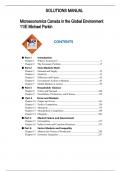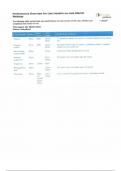SOLUTIONS MANUAL
Microeconomics Canada in the Global Environment
11/E Michael Parkin
CONTENTS
Part 1 Introduction
Chapter 1 What Is Economics? ......................................................................1
Chapter 2 The Economic Problem ...............................................................17
Part 2 How Markets Work
Chapter 3 Demand and Supply .....................................................................35
Chapter 4 Elasticity ......................................................................................51
Chapter 5 Efficiency and Equity ..................................................................65
Chapter 6 Government Actions in Markets ..................................................81
Chapter 7 Global Markets in Action.............................................................95
Part 3 Households’ Choices
Chapter 8 Utility and Demand ....................................................................109
Chapter 9 Possibilities, Preferences, and Choices ......................................125
Part 4 Firms and Markets
Chapter 10 Output and Costs ........................................................................141
Chapter 11 Perfect Competition ...................................................................159
Chapter 12 Monopoly ...................................................................................173
Chapter 13 Monopolistic Competition .........................................................189
Chapter 14 Oligopoly ...................................................................................203
Part 5 Market Failure and Government
Chapter 15 Externalities ...............................................................................217
Chapter 16 Public Goods and Common Resources ......................................231
Part 6 Factor Markets and Inequality
Chapter 17 Markets for Factors of Production .............................................243
Chapter 18 Economic Inequality ..................................................................257
, Chapter
1 WHAT IS
ECONOMICS?
Answers to the Review Quizzes
Page 2
1. List some examples of the scarcity that you face.
Examples of scarcity common to students include not enough income to afford both tuition
and a car, not enough learning capacity to study for both an economics exam and a chemistry
exam in one night, and not enough time to allow for extensive studying and extensive
socializing.
2. Find examples of scarcity in today’s headlines.
Scarcity is our inability to satisfy all our wants. An example of scarcity is the headline on
www.cbc.ca on March 30, 2020, which states “Farmers concerned about disruptions to spring
seeding, livestock operations amid COVID-19.” Farmers are preparing to plant their crops,
and supply disruptions mean that farmers are unable to plant all the crops that they want.
Farmers also want to hire foreign workers to help on livestock farms but a scarcity of foreign
workers means that they can’t hire the number of workers that they want. Farmers face
scarcity.
3. Find an example of the distinction between microeconomics and
macroeconomics in today’s headlines.
Microeconomics: On March 30, 2020, a headline in The Globe and Mail was “For graduating
students, high anxiety as COVID-19 decimates job market.” This story covers a
microeconomic topic because it discusses choices made by students and businesses, and
how they interact in the labour market.
Macroeconomics: On March 30, 2020, a headline in The Globe and Mail was “Canadian dollar
weakens over 1 per cent as oil prices slide.” This story covers a macroeconomic topic
because it concerns the effect of performances of the Canadian and world economy on the
Canadian dollar.
Page 7
1. Describe the broad facts about what, how, and for whom goods and services are
produced.
What we produce varies over time. In Canada today, services account for 70 percent of
production, manufactured goods for 28 percent, and agriculture for 2 percent. What we
produce also varies over countries. Agriculture and manufacturing are small percentages of
production in rich countries and large percentages of production in poorer countries.
How goods and services are produced is by businesses determining how the factors of
production, land, labour, capital, and entrepreneurship, are combined to make the goods and
services we consume. Land includes all natural resources, both renewable natural resources
such as wood, and nonrenewable natural resources such as natural gas. The quality of labour
depends on human capital. In Canada in 2020, 28 percent of the adult population had a
, university degree, a further 37.6 percent had some post-secondary education, and 95.7
percent had completed high school.
For whom goods and services are produced depends on the incomes that people earn.
People with large incomes can buy a wide range of goods and services. People with small
incomes can afford a smaller range of goods and services.
2. Use headlines from the recent news to illustrate the potential for conflict between
self-interest and the social interest.
One example of an issue that illustrates the potential for conflict between self-interest and the
social interest is the proposed Trans Mountain Pipeline. In the Financial Post on January 20,
2020, the headline “Supreme Court dismisses B.C. case against Trans Mountain Pipeline”
appears. The potential for conflict exists between the self-interest of the potential workers
whose employment is being delayed or possibly eliminated and the social interest of those
concerned about the environment.
Page 10
1. Explain the idea of a tradeoff and think of three tradeoffs that you have made
today.
A tradeoff is an exchange—giving up one thing to get something else. What is given up is the
opportunity cost of whatever is obtained. Three examples of tradeoffs are: a) When a student
sleeps in rather than attending his early morning economics class, the student trades
additional sleep for study time. The opportunity cost of the decision is the difference between
the A and the C he receives on the exam. b) When a student running late for class parks her
car illegally, the student trades saving time for the risk of a ticket. The potential opportunity
cost of the decision is the goods and services that cannot be purchased if the student
receives an expensive parking ticket. c) A student trades higher income by spending time
during the day working at a part-time job for less time spent at leisure. The opportunity cost of
the higher income is the leisure time given up.
2. Explain what economists mean by rational choice and think of three choices that
you’ve made today that are rational.
A rational choice is one that compares the costs and benefits and achieves the greatest
benefit over cost for the person making the choice. Three rational choices are: a) The choice
to skip breakfast to go to class. In this case the benefit is the higher grade in the class and the
cost is the breakfast forgone. b) The choice to stop talking with a friend on the phone and
start studying for an impending exam. In this case the benefit is the resulting higher grade in
the class and the cost is the conversation forgone. c) The choice to do laundry today rather
than watch television. In this case the benefit is clean clothes to wear and the cost is the loss
of the entertainment the television show would have provided.
3. Explain why opportunity cost is the best forgone alternative and provide
examples of some opportunity costs that you have faced today.
When a decision to undertake one activity is made, often many alternative activities are no
longer possible. Often these activities are mutually exclusive so only the highest-valued
alternative is actually forgone. For instance, the decision to go to a student’s 8:30 AM class
eliminates the possibility of sleeping in during the hour and of jogging during the hour. But in
this case, it is impossible to both sleep in and to jog during the hour, so the opportunity cost of
attending class cannot be both activities. The opportunity cost of attending class is only the
activity that otherwise would have been chosen—either sleeping in or jogging—whatever
activity is the most highly valued of the forgone alternatives.
, 4. Explain what it means to choose at the margin and illustrate with three choices
at the margin that you have made today.
Choosing at the margin means choosing to do a little more or a little less of some activity.
Three examples are: a) When a student faces a chemistry and an economics final exam in
one day, the student must determine whether spending the last hour studying a little more
chemistry or a little more economics will yield a better contribution (marginal benefit) to his
overall GPA. b) A student buying a computer must decide whether the marginal benefit of
adding 1 GB of additional memory is worth the marginal cost of the additional memory. c) A
student football fan with a choice of a cheap seat in the student bleachers located at the far
end of the playing field or a more expensive seat located on the 30 yard line must determine
whether the marginal benefit of watching the game in a better seat is worth the marginal cost
of the higher ticket price.
5. Explain why choices respond to incentives and think of three incentives to which
you have responded today.
People making rational decisions compare the marginal benefit of an action to its marginal
cost. A person’s choice changes when the incentive—the marginal benefit or the marginal
cost changes. Examples of incentives are: a) A student studies because of the incentives
offered by grades. b) A student is more likely to attend a class if attendance is factored into
the grade. c) A student might attend a meeting of a club if the student’s significant other is
eager to attend the meeting.
Page 11
1. Distinguish between a positive statement and a normative statement and provide
examples.
A positive statement is about what is. It is testable. A normative statement is about what ought
to be. It is not testable because there is no universally approved criterion by which the
statement can be judged. “I will receive an A for this course,” is a positive statement made by
an economics student—it might not be true, but it is testable. “I will receive a good grade for
this course,” is a normative statement. Whether someone agrees with it depends on his
interpretation of what makes for a “good” grade.
2. What is a model? Can you think of a model that you might use in your everyday
life?
A model is a description of some aspect of the world. An economic model is a description of
some aspect of the economic world that includes only those features that are needed for the
purpose at hand. An example of a model is a GPS map. It reflects only those aspects of the
real world that are relevant to the user in reaching her destination and avoids information
irrelevant to travel.
3. How do economists try to disentangle cause and effect?
Economists disentangle cause and effect by using natural experiments (situations in the
ordinary course of economic life in which the one factor of interest is different and other things
are equal or similar); conducting statistical investigations to find correlations; and performing
economic experiments by putting people in decision-making situations and varying the
influence of one factor at a time to discover how they respond.
4. How is economics used as a policy tool?
Individuals, businesses, and governments use economics as a policy tool. Individuals use the
economic ideas of marginal benefit and marginal cost when making decisions for such topics
as attending university, paying cash or credit for a purchase, and working. Businesses also





